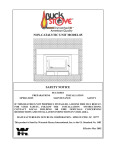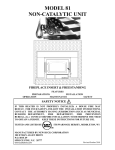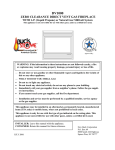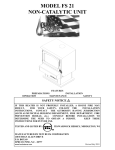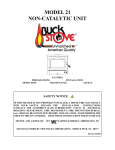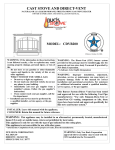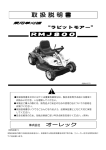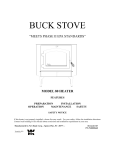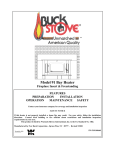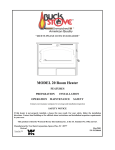Download New Buck Corporation 81 User's Manual
Transcript
NON-CATALYTIC UNIT MODEL 81 BUCK STOVE SAFETY NOTICE FEATURES PREPARATIONS OPERATION INSTALLATION MAINTENANCE SAFETY IF THIS HEATER IS NOT PROPERLY INSTALLED, A HOUSE FIRE MAY RESULT. FOR YOUR SAFETY, FOLLOW THE INSTALLATION INSTRUCTIONS. CONTACT LOCAL BUILDING OR FIRE OFFICIALS CONCERNING RESTRICTIONS AND INSTALLATION INSPECTIONS IN YOUR AREA. MANUFACTURED BY NEW BUCK CORPORATION - SPRUCE PINE, NC 28777 This product is listed by Warnock-Hersey International, Inc. to the UL Standard No. 1482 Revised May 2001 TABLE OF CONTENTS Important Instructions......................................................................................................... 3 SECTION I: Introduction ................................................................................................... 4 SECTION II: Masonry Insert Installation........................................................................... 5 Installation Preparation-Fireplace....................................................................................... 7 Mounting the Trim Panels .................................................................................................. 8 SECTION III: Pre-Fab Insert Installation......................................................................... 12 SECTION IV: Residential Freestanding Installation........................................................ 13 Freestanding Installation Clearances ................................................................................ 21 Installation of Close Clearances Shields........................................................................... 23 SECTION V: Freestanding Mobile Home Installation..................................................... 24 SECTION VI: Wood Heater Safety.................................................................................. 29 SECTION VII: Operation ................................................................................................. 30 SECTION VIII: Room air blower operation ................................................................... 32 SECTION IX: Troubleshooting........................................................................................ 33 Parts List ........................................................................................................................... 36 Warranty ........................................................................................................................... 37 1 2 INSTALLATION, OPERATION, AND MAINTENANCE INSTRUCTIONS MODEL 81 READ THIS FIRST IMPORTANT INSTRUCTIONS WARNING THESE UNITS GENERATE A LOT OF HEAT, SO TREAT THEM WITH CARE. HOT WHILE IN OPERATION. KEEP CHILDREN, CLOTHING AND FURNITURE AWAY. CONTACT MAY CAUSE SKIN BURNS. READ ALL INSTRUCTIONS BEFORE INSTALLING AND USING THE APPLIANCE. FAILURE TO FOLLOW INSTRUCTIONS MAY RESULT IN PROPERTY DAMAGE, BODILY INJURY, OR EVEN DEATH. SAVE THESE INSTRUCTIONS FOR FUTURE REFERENCES. • The New Buck Corporation non-catalytic system has been tested by Intertek Testing Services, Warnock Hersey to ANSI/UL Standards 1482. • Install and operate your units according to instructions provided in this manual. Local building codes may apply; therefore, contact your local building inspector or fire marshal for necessary installation requirements and permits which may go beyond these instructions. • If appliance is installed in mobile homes: “DO NOT INSTALL IN SLEEPING ROOMS.” • Examine the masonry fireplace and chimney prior to installation of the fireplace accessory to determine that the construction meets the minimum fireplace construction requirements illustrated in the instructions, that it is free from cracks, loose mortar, creosote deposits and other blockage, or other signs of deterioration. CAUTION DO NOT USE MORE THAN ONE STOVE TO A CHIMNEY. DO NOT USE A FLUE INTENDED FOR A GAS APPLIANCE. DO NOT CONNECT THIS UNIT TO A CHIMNEY FLUE SERVING ANOTHER APPLIANCE. DO NOT CONNECT TO ANY AIR DISTRIBUTION DUCT OR SYSTEM. • A factory-built pre-fabricated chimney may be used for your units when installed in compliance with the manufacturer's specification and uniform building code. 3 CAUTION YOUR CHIMNEY MUST BE CORRECTLY SIZED. A CHIMNEY THAT IS TOO SMALL OR LARGE IN DIAMETER, OR TOO SHORT, CAN CAUSE YOUR STOVE TO SPILL SMOKE WHEN THE DOOR IS OPENED. SECTION I INTRODUCTION Your stringent achieved the unit's Buck Stove is a non-catalytic unit designed to meet the most emissions standards without the use of a catalytic combustor. This effect is through the use of a secondary air which is mixed with primary air in firebox. For peak performance we suggest the use of hard seasoned wood. DO NOT BURN GARBAGE OR FLAMMABLE FLUIDS. The primary air, which is controlled by the user, burns the wood. Secondary air is admitted into the firebox through the secondary air tubes at the top of the firebox. This secondary air burns the impurities in the smoke released from the initial wood burning. The temperature necessary for this combustion is maintained through the firebrick refractory. If any more technical information is necessary, contact your local dealer. This heater is equipped with a standard room air blower. For operation and use of these electrical assemblies, see instructions provided in this manual on page 30. 4 SECTION II MASONRY INSERT INSTALLATION The Model 81 may be installed using an all masonry fireplace built in accordance with the Uniform Building Code and National Fire Protection Association (NFPA). The first step in this type of installation is to determine the acceptability of the fireplace and chimney for use with a woodstove. Both the construction and condition of the fireplace are important considerations when installing a woodstove. It is not necessary to direct connect this unit unless installed in improper drawing fireplace or oversized flue. The chimney should extend at least 3' above the roof and at least 2' above any point of the roof within 10'. CAUTION REMEMBER TO HAVE YOUR CHIMNEY INSPECTED FOR LEAKS AND BLOCKAGE BEFORE YOU INSTALL YOUR STOVE. E F D B C A Figure 1 MODEL 81 A. B. C. D. E. F. Unit to adjust to Side Wall Front Floor Protector Side Floor Protector Side Wood Trim Top Wood Trim Mantel or Brackets 5 12" 16" 8" 7" 10" 21" MINIMUM CLEARANCES 1. The hearth must be of masonry construction and must extend a minimum of 16” in front of the firebox opening and a minimum of 8" to either side of the firebox opening. 2. If there is not minimum hearth protection from the front of the firebox opening and the front of the masonry hearth, a floor protector must be used in front of the hearth to protect combustible materials. The floor protector must be 3/8" minimum thickness noncombustible material or equivalent. With the floor protector or hearth extension material specified as one layer of 2" thick brick with a K* factor of 5.0, you may use alternate materials as long as the K* factor (s) is calculated as follows: FORMULA: Required thickness = (K of alternate material/K of millboard) X (thickness of millboard) EXAMPLE: An alternate inorganic non-combustible millboard with a K* of .9375 would require a thickness as follows: Required thickness = (.9375/5.0) x 2 in. = 3/8 inch K* FACTORS OF ALTERNATE MATERIALS Material Ceroform 126 Limestone Concrete Sandstone Marble K .21 8.0 8.0 13.0 18.0 Required Thickness 1/8" 3.2" 3.2" 5.2" 7.2" Hearth extension or floor protector thickness above four (4) inches are generally not acceptable due to cost, floor load capacity, and look. The alternate we recommend is using Ceroform No. 126 millboard 1/8" minimum and putting any type decorative brick or stone (any thickness) on top of it. * The K* factor represents the thermal conductivity of a material and is the time rate of heat flow through a homogeneous material under steady-state conditions, through unit area, per unit temperature gradient in the direction perpendicular to a surface. 6 POSSIBLE TOOLS NEEDED FOR INSTALLATION If you decide to install your own stove, there are several hand tools you may need to do the job. If you do not already have them, they are readily available at most hardware stores. Caulking gun Large adjustable wrench (may not be needed) Drop Cloths Vacuum cleaner or whisk broom Flashlight 1 tube of RTV silicone, Code 103 or 106, or high temperature rubber cement rated between 450o F. - 600o F. 7/32" drill bit and drill Socket/Ratchet Set Insulation (provided in trim kit package) INSTALLATION PREPARATION FIREPLACE 1. Locate furniture and other materials away from the front of the fireplace to allow free access to the fireplace. 2. Cover the hearth and adjacent floor areas with the drop cloth to protect from soiling or marring the surface. 3. Remove the existing fireplace damper plate. 4. Thoroughly clean the fireplace of ashes and soot. 5. If the fireplace has an ash dump or outside air provision, these must be sealed off with metal or tightly packed non-combustible insulation to prevent this cold air from entering the fireplace chamber. CAUTION CHECK THE CHIMNEY AND SMOKE CHAMBER FOR EXCESSIVE BUILDUP OF CREOSOTE OR SOOT. ALSO CHECK FOR OBSTRUCTIONS, SUCH AS BIRD'S NESTS. IF THE CHIMNEY IS EXCESSIVELY DIRTY CLEAN IT, OR HAVE SOMEONE CLEAN IT PROFESSIONALLY BEFORE INSTALLING OR USING THE ROOM HEATER. 7 Installation Procedure Positioning the Heater NOTE: It is not necessary to direct connect this unit unless installed in improper drawing fireplace or oversized flue. It is recommended a chimney connector be installed from the appliance flue collar to the first fireplace chimney section. WARNING WHEN POSITIONING THE HEATER, THE FOLLOWING CONDITIONS MUST BE MET! 1. The front of the damper opening must be positioned BEHIND the rear edge of the lintel to ensure proper draft. 2. Center the heater in the fireplace opening. Mounting the Trim Panels After the unit is positioned, mark the mounting position of the trim panels as follows: 1. Set the side trim panels in place, flat against the face of the fireplace. Mark down the inside edge of the trim panel to make a vertical reference line. 2. Set the top (long) trim panel in place on top of the unit. The panel should be flat against the outside face of the fireplace, and standing vertically. Mark along the lower edge of the trim panel with a pencil to make a reference line for mounting. 3. Slide the unit out of the fireplace far enough to work behind the trim panel reference lines. 4. Mount the side trim panels. (See Figure 2.) a. Position the trim panel on the reference line. b. Drill mounting holes in center of trim panel mounting brackets to allow for adjustment in and out if necessary. c. Mount the trim panel using the self-tapping screws provided. 5. Place top panel back on reference mark. Take top trim panel mounting bracket supplied with unit. Position bracket so it overlaps rear lip of top trim panel. Drill mounting holes in top of stove using holes in bracket as guide. Tighten down screws. 6. Now, follow the installation procedures in the listed direct connect or positive connect kit you are using and install the heater and connect kit in the fireplace. 8 Figure 2 7. Slide the unit back into the fireplace. Check to be sure that the trim panels are properly positioned and lie flat against the front of the fireplace. If one of more of the panels is out of position, slide the unit out and reset by loosening the mounting screws and repositioning in the slot. 8. Reinstall the top trim panel by sliding the rear lip of the top trim panel underneath the front lip of the mounting bracket already secured to top of unit. NOTE: Mount the top trim panel so that it sits in front of the top of the side trim panels. 9. Obtain the brass trim kit provided with unit and slip over the top and sides of trim panels. (Top ends of brass may need to be trimmed to fit. 10. If direct connect or positive connect kit is not used, follow instructions in steps 1-4c on previous page. 11. Mount top trim panel by drilling mounting holes in center of trim panel mounting brackets, with top end side of top panel overlapping side panel. 12. Using insulation provided, peel and stick to back of panels overlapping fireplace dimensions by 1" on each side and top. (See Figure 3.) 13. Next using high heat silicone or furnace cement run heavy bead of caulking around where panels meet the stove. (See Figure 3.) 9 14. Slide the unit back into the fireplace. Check to be sure that the trim panels (and brass) are properly positioned and lie flat against the front of the fireplace. If panels are out of position, slide the unit out and reset by loosening the mounting screws and repositioning in the slot. With bar, lift stove in front. Place insulation across front and the surface of hearth or bottom of fireplace, to make complete seal. 15. To check seal of panels, use candle flame and go around the entire area sealed by silicone and insulation. If flame leans toward inside of fireplace, add additional insulation. This ensures an airtight seal. Figure 3 Final Check 1. Recheck the specified clearances. 2. Remove all foreign material from the firebox area. 3. Open the primary air draft. NOTE: Plug the power cord into a 115V AC outlet. Set switch to “Manual” and rheostat to “High” position to ensure motor operates properly. Route the cord to prevent damage to the cord insulation from heat and sharp objects. Keep the cord out of the way of traffic to prevent damage caused by tripping, etc. 10 4. Place crumpled pieces of newspaper in the stove. Light it and close the doors. Ensure that the stove draws properly through the primary draft. NOTE: “Do not use grate or elevate fire. Build wood fire directly on floor of stove.” 5. Check for smoke leaks around the doors. 6. Open the doors and check for smoke escaping from the front of the stove. Smoking usually indicates a defective or poorly positioned chimney. Some chimneys with a marginal draft can be preheated by lighting newspaper and holding it near the open damper with a poker or fire tong. Once the chimney heats up, a proper draft can usually be obtained. If a thorough review of the Troubleshooting Guide in the rear of the manual does not reveal the problem, contact your dealer for assistance. CAUTION THE UNIT IS PAINTED WITH A SPECIALLY FORMULATED HIGH TEMPERATURE PAINT THAT CURES DURING THE FIRST TWO OR THREE FIRINGS. YOU MAY NOTICE A SLIGHT SMOKING EFFECT AND AN ODOR OF BURNING PAINT WHEN YOU BUILD THE FIRST FIRES. THIS IS NORMAL AND IS NOT A CAUSE FOR ALARM. IN SOME CASES, THESE FUMES WILL ACTIVATE A SMOKE ALARM. OPENING A WINDOW NEAR THE UNIT WILL ALLOW THESE FUMES TO ESCAPE. DO NOT BUILD A LARGE, ROARING FIRE UNTIL THIS CURING IS COMPLETE OR THE HEATER FINISH MAY BE DAMAGED. The connector and/or chimney should be inspected at least once a month during the heating season to determine if a creosote buildup has occurred. CAUTION NEVER USE GASOLINE, GASOLINE-TYPE LANTERN FUEL, KEROSENE, CHARCOAL LIGHTER FLUID OR SIMILAR LIQUIDS TO START OR "FRESHEN UP" A FIRE IN THE HEATER. KEEP ALL SUCH LIQUIDS WELL AWAY FROM THE STOVE WHEN IT IS IN USE. ALL FLUIDS OF THIS TYPE GIVE OFF VOLATILE FUMES AND CAN AND WILL EXPLODE!! DON'T TAKE A CHANCE WITH THE SAFETY OF YOUR HOME AND FAMILY. 11 SECTION III PRE-FAB INSERT INSTALLATION The Model 81 may be installed into any UL listed pre-fabricated fireplace that is large enough to accept it. NOTE: When installing the Model 81 into a Pre-Fab Zero-Clearance fireplace, a UL-1777 LINER must be installed the Full Length of the chimney and attached to the flue exit of the Insert. NOTE: The ash lip, smoke baffle, and smoke shelf of the pre-fab fireplace may be removed if necessary to provide room for these models. Any other alteration to the unit will void ALL NBC manufacturer's responsibility, liability. The warning label below must be attached to the back of the fireplace. NOTE: Plug the power cord into a 115V AC outlet. Set switch to “Manual” and rheostat to “High” position to ensure motor operates properly. Route the cord to prevent damage to the cord insulation from heat and sharp objects. Keep the cord out of the way of traffic to prevent damage caused by tripping, etc. NOTE: DO NOT BLOCK ANY EXISTING LOUVERS OR VENTS ON THE EXISTING PRE-FAB WITH ANY TRIM PANELS FOR THE MODEL 81. Except for the “NOTES” above, please follow the instruction of masonry installation, Section II. Instruction Minimum clearances for stove Minimum clearances for floor protector WARNING: This fireplace must be restored to it’s original condition for safe use if the fireplace insert is removed. 12 SECTION IV RESIDENTIAL FREESTANDING INSTALLATION MINIMUM CLEARANCE TO COMBUSTIBLE MATERIAL PREPARING THE STOVE FOR INSTALLATION 1. Inspect the unit for any obvious physical damage. NOTE: Plug the power cord into a 115V AC outlet to test the fan and motor. Set switch to “Manual” and rheostat to “High” position to ensure motor operates properly. Route the cord to prevent damage to the cord insulation from heat and sharp objects. Keep the cord out of the way of traffic to prevent damage caused by tripping, etc. 2. Check the primary air draft control to ensure that it slides freely. 3. Remove any items from within the firebox. Spread the drop cloth on the floor behind the heater. Next, tilt the heater so that the back is on the drop cloth. 4. If leg kit is to be used follow steps 1-3. Then obtain legs, bolts, washer & nuts. Attach the legs to holes in bottom of unit. 5. If pedestal kit is being used, open the corresponding freestanding kit and obtain the stand. Place the stand against the bottom of the heater (angle side to heater) at the marked line. Center the stand left and right and mark screw locations on bottom through outer holes of stand mounting angles. Set stand aside and drill four 7/32" holes in heater bottom. (See Figure 4.) Figure 4 6. Obtain four 1/4" self-tapping screws and secure the stand to the heater. 7. Reposition the heater to the upright position. 13 ALTERNATE FLOOR PROTECTORS MATERIAL Floor protector must be 3/8" minimum thickness non-combustible material or equivalent. With the floor protector or hearth extension material specified as one layer of 2" thick brick with a K* factor of 5.0, you may use alternate materials as long as the K* factor (s) is calculated as follows: FORMULA: Required thickness = (K of alternate material/K of millboard) X (thickness of millboard) EXAMPLE: An alternate inorganic non-combustible millboard with a K* of .9375 would require a thickness as follows: Required thickness = (.9375/5.0) x 2 in. = 3/8 inch K* FACTORS OF ALTERNATE MATERIALS Material Ceroform 126 Limestone Concrete Sandstone Marble K .21 8.0 8.0 13.0 18.0 Required Thickness 1/8" 3.2" 3.2" 5.2" 7.2" Hearth extension or floor protector thickness above four (4) inches are generally not acceptable due to cost, floor load capacity, and look. The alternate we recommend is using Ceroform No. 126 millboard 1/8" minimum and putting any type decorative brick or stone (any thickness) on top of it. * The K* factor represents the thermal conductivity of a material and is the time rate of heat flow through a homogeneous material under steady-state conditions, through unit area, per unit temperature gradient in the direction perpendicular to a surface. 14 Chimney These models are designed for connection to: (1) Simpson Duravent - Dura Black (2) Metal Fab (3) Ameritec - BSR NOTE: This Room Heater must be converted to (1) a chimney complying with the requirements for Type HT chimneys in the Standard for chimneys, Factory-Built, Residential, Type and Building Heating Appliance, UL 103, or (2) a code approved masonry chimney with a flue liner. The chimney size should not be less than nor more than 3 times greater than the cross-sectional area of the flue collar. CAUTION SPECIAL METHODS ARE REQUIRED WHEN PASSING THROUGH A WALL OR CEILING. SEE INSTRUCTIONS AND BUILDING CODES. DETERMINING THE CHIMNEY LOCATION A. Ceiling Exits: (Using 6" Single Wall Pipe and UL system listed with manufacturer in this section of manual.) 103 HT type chimney 1. Suspend a plumb bob from the ceiling above the unit so that the weight is hanging in the center of the flue exit. (A small weight on a string will serve as a plumb bob.) Mark the ceiling where the string is suspended to locate the center of the chimney. 2. After locating the center of the hole, install the ceiling support box, chimney, flashing and rain cap per the chimney manufacturer's instructions. 3. Now connect the stove and ceiling support box using #24 ga. minimum blued or black steel connector pipe. (DO NOT USE GALVANIZED PIPE.) Connect each section so the crimped end faces downward, and secure each section to each other using at least 15 three (3) sheet metal screws or rivets. Next, install an optional New Buck Corporation chimney connector to the flue exit of the heater or you may use “Ell” brackets to fasten the pipe to the stove. 4. Install Single Wall Connector and chimney system per manufacturer’s written operating instructions. See manufacturer’s list of tested pipes in this manual. Figure 5 Figure 6 B. Wall Exit Into Metal Tee-Box 1. Mark the plumb line on the wall directly behind the center of the heater. (See Figure 6.) NOTE: When using #24 ga. minimum blue or black steel pipe maintain 18" between pipe and ceiling. 2. Place the vertical portion of the heater pipe and the elbow in position and project a point onto the plumb line level with the center of the elbow. 3. Measure up so there will be at least 1/4" rise per foot of horizontal connector pipe, 16 maintaining clearances to the ceiling as noted in Figure 6. This will give you the center of the hole for the chimney penetration. 4. After locating the center of the penetration, install the tee box and chimney as per the chimney manufacturer's specifications. 5. Connect the chimney collar to the tee-box using #24 ga. minimum blued or black steel connector pipe. (DO NOT USE GALVANIZED PIPE.) Connect each section so the crimped end faces downward, and secure each section to each other using three (3) sheet metal screws or rivets. C. Wall Exit Into Masonry (Using Single Wall Pipe) 1. Before connecting these units to a masonry chimney, determine that the masonry fireplace wall pass-through connector thimble meets the NFPA-211 Code and local building codes and is a minimum of 18" from the ceiling. If the connector thimble does not meet these codes, the pass-through connector must be modified. (See Figure 7.) Figure 7 Connectors may pass through walls or partitions constructed of combustible material if the connector is: (a) Either listed for wall pass-through or is routed through a device listed for wall passthrough and is installed in accordance with the conditions of the listing. (b) Selected or fabricated in accordance with the conditions and clearances as stated in the NFPA-211 Code. Any unexposed metal that is used as part of a wall pass-through system and is exposed to flue gases shall be constructed of stainless steel or other equivalent material that will resist corrosion, softening, or cracking from flue gases at temperatures up to 1800o F. 17 NOTE: In addition, a connector to a masonry chimney shall extend through the wall to the inner face or liner but not beyond, and shall be firmly cemented to masonry. EXCEPTION: A thimble may be used to facilitate removal of the chimney connector for cleaning, in which case the thimble shall be permanently cemented in place with hightemperature cement. 2. Once the through-the-wall thimble codes are met, simply connect the chimney collar to the wall pass-through connector using #24 ga. minimum, blued or black steel connector pipe as follows: (a) Maintain 1/4" rise per foot (horizontal length) from the appliance to the chimney. (b) Connect each section so the crimped end faces downward or back toward the unit. (c) Secure each section to each other using at least three (3) sheet metal screws or rivets. (d) Use three (3) sheet metal screws to fasten pipe to connector collar on heater. D. Ceiling Exit-Close Clearance 1. Suspend a plumb bob from the ceiling above the unit so that the weight is hanging in the center of the flue exit. (A small weight on a string will serve as a plumb bob.) Mark the ceiling where the string is suspended to locate the center of the chimney hole. 2. After locating the center of the hole, install the ceiling support box, chimney flashing and rain cap. 3. Now connect the stove and ceiling support box using #24 ga. minimum blued or black steel connector pipe. (DO NOT USE GALVANIZED PIPE.) Connect each section so the crimped end faces downward, and secure each section to each other using at least three (3) sheet metal screws or rivets. Next, install an optional New Buck Corporation chimney connector to the flue exit of the heater or you may use “Ell” brackets to fasten the pipe to the stove. 4. Install Single Wall Connector and chimney system per manufacturer’s written operating instructions. See manufacturer's list of tested pipes in this manual. 18 CEILING SUPPORT BOX OPTIONAL SINGLE WALL PIPE CHIMNEY CONNECTOR Figure 8 Close Clearance Installation using: (1) 6" Simpson Dura-Vent single wall chimney connector Dura Black and 6" Simpson Dura-Vent 2100 Deg Ht. “Type DP” chimney. (2) 6" Metal Fab Type single wall connector- 6" Metal Fab 2100 HT chimney. (3) Ameritec. For minimum clearances see pages 20 & 21. ALCOVE INSTALLATION CLEARANCES Must use 6" Single Wall Connector and 6" Type HT Pipe listed for close clearance reduction listed in this manual. For minimum clearances see pages 21 & 22. Must also use close clearance shield kit. 19 FINAL CHECK 1. Recheck the specified clearances. 2. Remove all foreign material from the firebox area. 3. Open the primary air draft. NOTE: Plug the power cord into a 115V AC outlet. Set switch to “Manual” and rheostat to “High” position to ensure motor operates properly. Route the cord to prevent damage to the cord insulation from heat and sharp objects. Keep the cord out of the way of traffic to prevent damage caused by tripping, etc. 4. Place crumpled pieces of newspaper in the stove. Light it and close the doors. Ensure that the stove draws properly through the primary draft. 5. Check for smoke leaks around the doors. CAUTION Open the doors and check for smoke escaping from the front of the stove. Smoking usually indicates a defective or poorly positioned chimney. Some chimneys with a marginal draft can be preheated by lighting newspaper and holding it near the open damper with a poker or fire tong. Once the chimney heats up, a proper draft can usually be obtained. If a thorough review of the Troubleshooting Guide in the rear of the manual does not reveal the problem, contact your dealer for assistance. CAUTION The unit is painted with a specially formulated high temperature paint that cures during the first two or three firings. You may notice a slight smoking effect and an odor of burning paint when you build the first fires. This is normal and is not a cause for alarm. In some cases, these fumes will activate a smoke alarm. Opening a window near the unit will allow these fumes to escape. DO NOT build a large, roaring fire until this curing is complete or the heater finish may be damaged. 20 CLEARANCES FOR MODEL 81 MINIMUM CLEARANCES TO COMBUSTIBLES FREESTANDING BACK WALL SIDE WALL B G C A 8" F C D D C 8" E HEARTH PAD A B 16" D Figure 9 MODEL A B C D MODEL 81 23" 23" 25" 16" NOTE: All clearances are to combustibles without low clearance shields and using single wall pipe and minimum floor protector. Clearances above may be reduced. Follow NFPA-211 codes if available or follow instructions on next page. * Floor Protector at rear needed for thru-the-wall exit only. 21 CLEARANCES FOR MODEL 81 MINIMUM CLEARANCES TO COMBUSTIBLES SINGLE WALL CHIMNEY CONNECTOR AND OPTIONAL SHIELDS, MOBILE HOME AND ALCOVE INSTALLATIONS BACK WALL SIDE WALL AB CE 8" D C DC B 8" 16" AC Figure 10 MODEL A B C D MODEL 81 12" 16" 12.5" 12" NOTE: All clearances are to combustibles using single wall pipe and all low clearance shields and minimum floor protector. *Floor protector at rear needed for thru-the-wall exit only. 22 INSTALLATION OF CLOSE CLEARANCE SHIELDS (Optional) 1. Take rear close clearance shield and center with back of stove using self-tapping screws. 2. Remove self-tapping screws from rear of stove. Align holes in side shield with holes in rear shield and attach to stove. 3. Before tightening the screws, insert the front end of the shield behind the side angle on the front side of the stove. Use the same step to install side shield on the opposite side of the stove. 4. Loosen two top screws holding side shield at rear top. Insert pipe shield where back shield and top rear side shield meets. Tighten screws. 23 SECTION V FREESTANDING MOBILE HOME INSTALLATION FOR MINIMUM CLEARANCES SEE PAGE 21. FLOOR PROTECTION Floor protector must be 3/8" minimum thickness non-combustible material or equivalent. With the floor protector or hearth extension material specified as one layer of 2" thick brick with a K* factor of 5.0, you may use alternate materials as long as the K* factor (s) is calculated as follows: FORMULA: Required thickness = (K of alternate material/K of millboard) X (thickness of millboard) EXAMPLE: An alternate inorganic non-combustible millboard with a K* of .9375 would require a thickness as follows: Required thickness = (.9375/5.0) x 2 in. = 3/8 inch K* FACTORS OF ALTERNATE MATERIALS Material Ceroform 126 Limestone Concrete Sandstone Marble K .21 8.0 8.0 13.0 18.0 Required Thickness 1/8" 3.2" 3.2" 5.2" 7.2" Hearth extension or floor protector thickness above four (4) inches are generally not acceptable due to cost, floor load capacity, and look. The alternate we recommend is using Ceroform No. 126 millboard 1/8" minimum and putting any type decorative brick or stone (any thickness) on top of it. * The K* factor represents the thermal conductivity of a material and is the time rate of heat flow through a homogeneous material under steady-state conditions, through unit area, per unit temperature gradient in the direction perpendicular to a surface. CHIMNEY These models are designed for connection to Simpson Duravent, HT-103 2100 deg pipe. 24 Metal Fab and Ameritec TOOLS FOR INSTALLATION Drop cloth 3/32" Metal drill bit 5/16" Magnetic socket chuck adapter, 5/16" wrench (box or socket) or adjustable wrench Jigsaw with masonry, metal and wood blades. WARNING: DO NOT INSTALL IN A SLEEPING ROOM. PREPARING THE HEATER FOR INSTALLATION 1. Inspect the unit for any obvious physical damage. NOTE: Plug the power cord into a 115V AC outlet. Set switch to “Manual” and rheostat to “High” position to ensure motor operates properly. Route the cord to prevent damage to The cord insulation from heat and sharp objects. Keep the cord out of the way of traffic to prevent damage caused by tripping, etc. 2. Check the primary air draft control to ensure it operates freely. 3. Remove any items from within the firebox. Spread the drop cloth on the floor behind the heater. Next, tilt the heater so that the back is on the drop cloth. 4. Open the proper outside air freestanding kit and obtain the stand. Place the stand against the bottom of heater (angle side to heater). Center the stand left to right and front to back and mark screw locations on bottom through outer holes of stand mounting angles. Set stand aside and drill four 3/32" holes in heater bottom. 5. Before attaching the heater to the stand, take a large flat screwdriver or pliers and remove the 2"x2" knockout on bottom of the unit. 6. Obtain four 3/16" self-tapping screws and secure the stand to the heater. 7. Reposition the heater to the upright position. PREPARING THE ROOM HEATER LOCATION 1. Select an installation location that will give the best airflow from the front of the heater to the remainder of the home. 2. Place the protective floor pad in position. 3. Place the unit on the pad making sure the minimum clearance specifications are met. 4. Lightly mark with a pencil the location of the pedestal on the protective pad. 25 5. Next, remove the four (4) screws holding the heater to the stand. Position heater out of the way of the installation area. 6. Check that the pedestal stand is still aligned with the marks and now, mark the outside air opening of the stand on the pad. 7. Next, mark the center line of the outside air opening. Set stand aside for now. 8. Next, cut a 4 1/4" diameter hole in the pad and continue through the floor. CAUTION THE STRUCTURAL INTEGRITY OF THE MOBILE HOME FLOOR MUST BE MAINTAINED. (MOVE OPENING AND/OR REPOSITION HEATER LOCATION IF NECESSARY.) 9. Now, reposition the pedestal stand and set on the pad being sure to line the stand up with the reference marks. 10. Using an electric drill and 3/8" masonry bit, drill four (4) holes in the protective pad using the holes in the bottom side lips of the pedestal stand as a guide. Be careful to drill only through the pad and not into the floor. Change the bit to a 1/4" metal bit and drill through the floor. 11. Using four (4) 3/8" x 1-1/2" lag bolts, secure the pedestal stand and pad to the floor of the mobile home. CAUTION IF A THICK FLOOR PROTECTOR IS USED, YOU MAY HAVE TO USE LONGER LAG BOLTS. 12. Set the heater back onto the stand and resecure using the screws. 13. Obtain the outside air duct from the box in the pedestal kit marked FA P21B. 14. From under the mobile home, slip the duct up through the 4-1/4" hole. Push up until the face of the outside air duct contacts the underside of the floor of the mobile home. For certain floor thickness, you may have to shorten the length of the outside air duct. 15. Secure the outside air duct to the floor using the four (4) #10 x 1" screws provided. Figure 12. 26 See RAIN CAP RAIN CAP 24" min. (610 mm) 24" min. (610 mm) 36" TYP. FLASHING 36" TYP. FLASHING RADIATION SHIELD RADIATION SHIELD 20 FT. MAX. OUTSIDE AIR DUCT THROUGH FLOOR WHEN MOBLE HOME IS NOT UNDERPENNED OUTSIDE AIR DUCT THROUGH UNDERPENNED Ceiling Exit (Using Close Clearance Listed Chimney) 1. Suspend a plumb bob from the ceiling above the unit so that the weight is hanging in the center of the flue exit. ( A small weight on a string will serve as a plumb bob.) Mark the ceiling where the string is suspended to locate the center of the chimney hole. 2. After locating the center of the hole install the ceiling support box, chimney or chimney connector, flashing and rain cap using listed chimney only. Only use pipe listed in this manual. CAUTION REFER TO CHIMNEY MANUFACTURERS INSTRUCTIONS FOR ASSEMBLY AND DISASSEMBLY OF CHIMNEY PARTS. BE SURE TO FOLLOW CHIMNEY INSTRUCTIONS FOR PROPER CLEARANCES TO COMBUSTIBLE AND PROPER AIR SPACING REQUIRED. 3. Add additional pipe until both of the following are met: 27 (a) Chimney pipe is 3' higher than roof at the point where it penetrates the roof. (b) Chimney pipe height is at least 2' higher than any part of the roof within 10' of the chimney. (See Figure 12.) 4. Next, install a New Buck Corporation chimney connector to the flue of the heater or use 3 “Ell” brackets and secure to the top of the heater and pipe. 5. Using single wall chimney connector, connect the heater to the chimney by following manufacturer’s installation instructions exactly. (See Figure 13.) CEILING SUPPORT BOX CHIMNEY CONNECTOR SINGLE WALL PIPE Figure 13 FINAL CHECK 1. Recheck the specified clearances. 2. Remove all foreign material from the firebox area. 3. Open the primary air draft. NOTE: Plug the power cord into a 115V AC outlet. Set switch to “Manual” and rheostat to “High” position to ensure motor operates properly. Route the cord to prevent damage to the cord insulation from heat and sharp objects. Keep the cord out of the way of traffic to prevent 28 4. Place crumpled pieces of newspaper in the stove. Light it and close the doors. Ensure that the stove draws properly through the primary draft. 5. Check for smoke leaks around the doors. 6. Open the doors and check for smoke escaping from the front of the stove. Smoking usually indicates a defective or poorly positioned chimney. Some chimneys with a marginal draft can be preheated by lighting newspaper and holding it near the open damper with a poker or fire tong. Once the chimney heats up, a proper draft can usually be obtained. If a thorough review of the Troubleshooting Guide in the rear of the manual does not reveal the problem, contact your dealer for assistance. CAUTION THE UNIT IS PAINTED WITH A SPECIALLY FORMULATED HIGH TEMPERATURE PAINT THAT CURES DURING THE FIRST TWO OR THREE FIRINGS. YOU MAY NOTICE A SLIGHT SMOKING EFFECT AND AN ODOR OF BURNING PAINT WHEN YOU BUILD THE FIRST FIRES. THIS IS NORMAL AND IS NOT A CAUSE FOR ALARM. IN SOME CASES, THESE FUMES WILL ACTIVATE A SMOKE ALARM. OPENING A WINDOW NEAR THE UNIT WILL ALLOW THESE FUMES TO ESCAPE. DO NOT BUILD A LARGE ROARING FIRE UNTIL THIS CURING PROCESS IS COMPLETE OR THE HEATER FINISH MAY BE DAMAGED. SECTION VI WOOD HEATER SAFETY Certain safety hazards are inherent in any wood heater installation. You should be aware of these so that a safe and proper installation can be made. 1. FAULTY CHIMNEY: An older masonry chimney should be thoroughly checked to be sure there are no holes or weak spots which could allow sparks or hot gases to escape. 2. HEAT CONDUCTION: Placing combustible materials too close to a heater or chimney can be a fire hazard. By keeping these particular hazards in mind as you install and use your room heater you can ensure a safe, reliable installation. 29 The chimney and chimney connector should be inspected once every two months. Any buildup of soot should be removed to prevent the risk of a chimney fire. To remove chimney or chimney connector: Remove screws or fasteners. Remove pipe and clean with steel brush. Replace chimney or chimney connector, and replace screws and/or fasteners. CAUTION NEVER USE GASOLINE, GASOLINE TYPE LANTERN FUEL, KEROSENE, CHARCOAL LIGHTER FLUID OR SIMILAR LIQUIDS TO START OR "FRESHEN UP" A FIRE IN THE HEATER. KEEP ALL SUCH LIQUIDS WELL AWAY FROM THE STOVE WHEN IT IS IN USE. ALL FLUIDS OF THIS TYPE GIVE OFF VOLATILE FUMES AND CAN AND WILL EXPLODE!! DON'T TAKE A CHANCE WITH THE SAFETY OF YOUR HOME AND FAMILY. DISPOSAL OF ASHES: Ashes should be placed in a metal container with a tight fitting lid. The closed container of ashes should be placed on a noncombustible floor or on the ground, well away from all combustible materials pending final disposal. If the ashes are disposed of by burial in soil or otherwise locally dispersed, they should be retained in the closed container until all cinders have thoroughly cooled. CREOSOTE-FORMATION AND NEED FOR REMOVAL: When wood is burned slowly, it produces tar and other organic vapors, which combine with expelled moisture to form creosote. The creosote vapors condense in the relatively cool chimney flue of a slow-burning fire. As a result, creosote residue accumulates on the flue lining. When ignited this creosote makes an extremely hot fire. SECTION VII OPERATION This section of the manual is to help you get the maximum efficiency and maximum smoke (particulate) reduction from your heater. If you should experience any difficulty or have any questions concerning your heater, contact your dealer for assistance. The manufacturer recommends that for maximum performance burn seasoned hard wood. Build a fire for maximum efficiency. These models burn wood and extract heat so efficiently, a large fire is not necessary. A large fire not only wastes energy, it usually results in the home being too warm for comfort. The following steps will serve as a guide for operating your stove. 30 BUILDING A FIRE 1. Open the door. 2. Open the primary air control located on right side of stove under hearth. To close push all the way in. To open pull all the way out. Adjustments to airflow may be made by positioning the handle anywhere in between. 3. Twist two pieces of non-colored newspaper into a roll and place them on the floor of the firebox. 4. These models are not designed for the use of grates, andirons or other methods of supporting the fuel. 5. Lay several pieces of dry kindling on top of the newspaper. 6. Place three or four small pieces of firewood, 2-3" in diameter, on top of the kindling. 7. Light the newspaper in the front, close and latch the door. Don't leave the fire unattended at this point. The draft system of the heater should start quickly. It may be necessary to preheat the chimney to get the draft started. To do this, open the door and add newspaper to the top rear of the wood. Light or let this paper ignite and allow to burn while holding the door slightly cracked. Once the draft has started, close and lock the door. You are over heating the unit if the chimney and/or connector glows red. 8. After embers and a coal bed have been established, load the heater with wood. NOTE: THE FUELING AND ASH REMOVAL DOORS MUST REMAIN CLOSED DURING OPERATION. Your unit does not have a damper. You must use the primary air lever for your control of the fire. To open, pull the lever out and to close push the lever in. 31 ROOM AIR BLOWER OPERATION Your heater is equipped with a room air blower. For operation and wiring see Figure 14. For your convenience your heater is equipped with a rheostat with which you are able to select the air flow. The auto and manual switch will allow you to select the position at which the thermostat will function. Figure 14 Auto-position: After heater has warmed up and the Auto-Manual switch is placed in “Auto” position and the rheostat is in the desired position, then the fan will automatically come on. When the stove cools off the fan will automatically shut-off. Manual position: You must turn the room air blower on and off. NOTE: Plug the power cord into a 115V AC outlet. Set switch to “Manual” and rheostat to “High” position to ensure motor operates properly. Route the cord to prevent damage to the cord insulation from heat and sharp objects. Keep the cord out of the way of traffic to prevent damage caused by tripping, etc. 32 SECTION VIII TROUBLESHOOTING PROBLEM 1. Sluggish heater POSSIBLE CAUSE 1. Obstruction in chimney 2. Improperly sealed trim kit or direct connect kit 3. Wet or unseasoned wood being burned. 4. Poor chimney draft 2. High Fuel Consumption 1. Improper regulation of draft or inlet air 2. Improper door fitting 3. Backpuffing 1. Gusts of Wind SOLUTION 1. Check for and remove obstruction 2. (a) Check trim kit gasketing seal to fireplace and gasket as necessary to seal unit. Gasket under front bottom of stove if needed. (b) Check seal if direct connect and correct. 3. Burn dry seasoned wood. 4. Improper chimney height or wrong size flue is being used. Cooler temperatures caused by external chimney. 1. Close inlet air control as much as possible to maintain desired heat output. Check gaskets, reinstall fiberglass gasketing around doors and glass as necessary. 2. Check door gasket, check adjustment of door latch, check door hinges. 1. Smoke shelf in chimney is filled with creosote & ash. Chimney may need wind diverter. Raise chimney for better draft. 1. Wind gusts blowing down 4. Smoke rollout when the chimney heater door is opened. 2. Opening heater door too fast 33 1. Smoke shelf in chimney is filled with creosote & ash. Chimney may need wind diverter. Raise chimney for better draft. 2. Open air control. Crack door for 15 seconds before fully opening door. EPA COMPLIANCE STATUS The Model 81 heater meets the U.S. Environmental Protection Agency’s Emission limits for wood heaters sold after July 1, 1992. Under specific conditions this heater has been shown to deliver heat at rates ranging from approximately 10,000 to 45,000 BTU/hr for the Model 81. MODEL 81 WOOD STOVE (41) (5) (39) (4) (20) (32) (16) (1) 1 (11) (7) (13) (37) & (38) (14) (40) (21) (18) (33) (15) (31) (27) (3) (8) (12) (2) (19) (35) 6 (36) (10) 1. 2. 3. 4. 5. 6. 7. 8. 9. 10. 11. 12. 13. 14. 15. Secondary air tubes Blower control (rheostat) Primary air control Warm air outlets Baffles (interior of stove) Air inlet Door Hearth extension Power cord Legs Stainless steel plate Automatic/off/man. switch Brass cap Hinge Block Brass overlays (28 (29) (23) (9) (34) (25) (24) (26) (22) 16. Brass overlay mounting screws 17. Door glass & logo 18. Glass clips 19. Hearth Brass 20. Door Gasket 21. Side glass 22. Leveling screws 23. Firebrick 24. Motor 25. Motor mount bracket 26. Cover Door 27. Cover door screws 28. Shot gun air box 29. Ash pan 34 (30) 30. Disc thermostat 31. Door handle & brass spring handle 32. Air wash screen 33. Glass gasket 34. Cover door hinge 35. Magnet holder 36. Cover door Magnet 37. Door latch 38. Door latch screw 39. Blanket 40. Hinge pins 41. 6" Flue exit REPLACEMENT PARTS FOR THE MODEL 81 1. Air Control Bar 2. Door Handle Assembly 3. Door Latch 4. Door Handle Washer 5. Front door bushing 6. Door Gold 7. Door Black 8. Carlingl Fan Auto/Man Switch 9. Thermostat 110 disc 10. Power Cord 11. Strain Relief 12. Motor 13. Rheostat 14. Rheostat knob 15. Glass 16. Glass, Bay side 17. Glass clip 18. Spring Handle 19. “U” Drive Screw 5/16" x 1/2" 20. Top Firebox Blanket 21. Secondary Air Tube 22. Bottom Firebox Blanket 23. Primary Air Block 24. Side Brass Overlay 25. Top Baffle Plate 26. Hearth Brass 27. 1" x 1" x 1/8" thick magnet 28. Firebrick MF 810084 PA 910096 PC 910098 PO 91WASH PO 910102 PC 212400G PC 212400 PE RC211RB PE 400132 PE 400240 PE 400320 PE 910714 PE BC204 PE BC204A PG 2124GL PG 810100 PH 103212HWSPS5 PO 100150 PO 516U PO 810013 PO 810050 PO 810054 MF 810081 PO 810104G PO 810116 PO 810705 PO DM841 PR 900050 35 NEW BUCK CORPORATION (NBC) “LIMITED WARRANTY” FOR THE BUCK STOVE PLEASE READ THIS WARRANTY CAREFULLY PRODUCTS COVERED This warranty covers the new Buck Stove heating unit, so long as it is owned by the original purchaser, including optional and standard accessories purchased at the same time, subject to terms, limitations, and conditions herein set out. PRODUCTS NOT COVERED This warranty does not cover the following: Glass; Refractory material such as refractory cement or firebrick; Gaskets. This Warranty will also not cover any damage and/or failure caused by abuse or improper installation of the products covered. WARRANTY TIME PERIODS (A) Period I For one year from the date of purchase, NBC will replace or repair, at its option, any part defective in materials or workmanship. The costs of parts only are included. The customer pays any labor or transportation charges required. Thereafter; (B) Period II For the period after the first year from the date of purchase and extending for 5 years as long as the Buck Stove is owned by the original purchaser, NBC will repair or replace, at its option, any part defective in materials or workmanship, with the exception of: electrical motors, wiring, switches, and components: optional and standard accessories; and all parts not permanently attached to the heating unit. Parts not permanently attached to the heating unit are defined as those items designed to be removed from the stove, including those removable with common hand tools. The costs of parts only are included. The customer pays any labor or transportation charges required. . PROCEDURE Should you feel that your BUCK STOVE is defective, you should contact any Buck Stove dealer for the name of your nearest authorized Buck Stove service representative, who will instruct you on the proper procedure, depending on which Warranty Time Period (Period I or Period II) applies. If for any reason you are dissatisfied with the suggested procedures, you may contact us in writing at: 36 New Buck Corporation Customer Service Department P. O. Box 69 Spruce Pine, NC 28777 CONDITIONS AND EXCLUSIONS A) Replacement of parts may be in the form of new or fully reconditioned parts, at NBC's option. B) There is no other express warranty. All implied warranties of Merchantability and Fitness for Use are limited to the duration of the Express Warranty. C) Buck Corporation is not liable for indirect, incidental, or consequential damages in connection with the use of the product including any cost or expense of providing substitute equipment or service during periods of malfunction or non-use. Some states do not allow the exclusion of incidental or consequential damages, so the above exclusion may not apply to you. D) All warranty repairs under this warranty must be performed by an authorized Buck Stove service representative. Repairs or attempted repairs by anyone other than an authorized service representative are not covered under this warranty. In addition, these unauthorized repairs may result in additional malfunctions, the correction of which is not covered by warranty. OTHER RIGHTS This warranty gives you specific legal rights, and you may also have other rights, which vary from state to state. 37







































